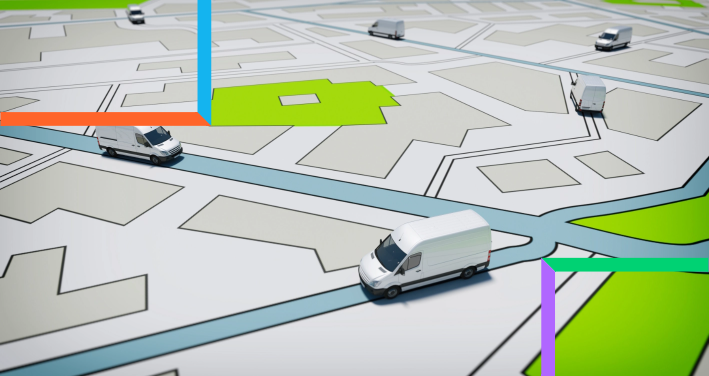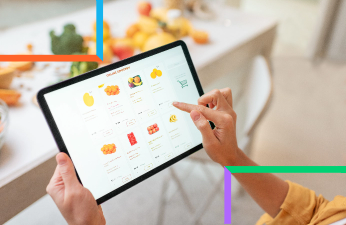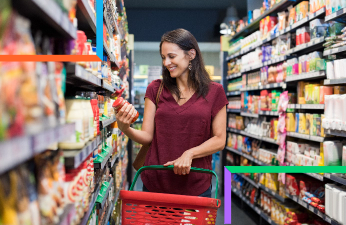There isn’t a time when there is a halt in shopping across the globe. But there are times when shopping frequency goes through the roof, namely - the Holiday and peak seasons. These times are when shippers and carriers get a lot of business. However, it's like a double edged sword. Due to increasing demand for faster, flexible and predictable deliveries from customers, companies are put under a lot of pressure to deliver on time and stay profitable. This isn’t realistic considering the current real-world constraints and use of legacy supply chain and logistics technology.
Global e-commerce and retail market overview
Back in early 2020, the retail e-commerce industry skyrocketed with the coming of the pandemic. A worldwide lockdown, combined with public-health concerns for both businesses and consumers, made digital sales boom in a very short period of time. Only those who were able to adapt and innovate amidst this crisis kept afloat.
According to Statista research, 2019 global retail e-commerce sales was around $3.3 trillion and soared to $4.3 trillion in 2020 due to the pandemic. Global sales for the industry in 2023 stands at 5.8 trillion and is expected to reach 8 trillion by 2027. This proved that consumers are fully continuing to embrace online shopping in droves so, making it imperative for shippers to make their delivery game top notch.

The peak season conundrum
During the peak season, shippers are burdened with catering to a large number of audiences within a short period of time. Purchases during this time hold a lot of sentimental value to the customers and any delays or failures could result in a shift in loyalty. According to salesforce research, global holiday season revenue reached $1.17 trillion in 2023. With this, one can imagine the volume of orders that shippers need to handle during peak season.
About your shoppers
The modern consumer is not easy to pin down. They exist under growing economic pressures with an increasing number of competitive options and their loyalty isn’t easily earned.
Millennials and Gen Xers lead the charge in online shopping, with a striking 67% of millennials and 56% of Gen Xers choosing the digital over the traditional retail experience. This trend isn't just about preference—it's about engagement. These groups dedicate 50% more time to browsing online stores than older generations of shoppers, clocking in at six hours compared to the latter's four. This significant difference in shopping habits underscores the growing shift towards online retail among younger consumers.
What does the modern customer want this peak season?
The reality is that brand loyalty is non-existent. Customer preferences are ever changing and dependent on demand, supply, quality of the product, and price sensitivity, among others.
One other aspect is the purchase experience itself. As per research, one in five customers abandon a purchase as delivery times are too slow. This means it is important to make the shopping journey seamless from the start to the finish. No opportunity with the customer should be missed, simply because there are very few to begin with.

Businesses must make the best use of data from all sources to get an insight into customer spending. This knowledge will determine content and creative planning, buying and optimization and will be key in fuelling long-term growth for your business. Speed and efficiency are also important to keep the customer happy and data must be used as a guide to understand customer patterns.
Sustainability practices, which were previously only somewhat important to customers, have grown to become a business imperative. Two-thirds of global consumers cite sustainability as a major contributor to purchasing decisions and this number grows when you isolate the data for young shoppers. Shipping methods that have a low carbon footprint and recycled packaging are the obvious steps forward.
Finally, in order to make sure customers receive their order on time while adhering to sustainable routes and staying profitable, organizations need to look at optimizing their last mile fulfillment.
Want to know how Locus can boost your profits?
The Last Mile Conundrum
The last mile is critical since it is, for a lot companies, the first in-person point of contact with customers.
The amount of complexities involved which leads to inefficiencies makes it the most expensive compared to first and mid mile as attested by Capgemini report of 41% of total supply chain costs are from last mile delivery.
Each last-mile delivery connects, depends on and relied upon by various stakeholders in the supply chain. Unpredictability sits at the center of last-mile deliveries and fulfillment timelines are constantly tightening. The last mile is an expensive affair with visibility being a common and persistent issue.

What makes the last-mile the most challenging?
For one, retailers find themselves unable to meet peak season demands due to limited fulfillment capacity.
Inefficient route planning, leading to extra miles driven, more fuel spent, and thereby an extra burden on drivers and dispatchers.
Very often, resources are unavailable at customer’s preferred times and even if they are, planning tasks for specific time windows is difficult with human intelligence alone.
Incorrect customers addresses that could make the delivery teams drive around in circles and pester customers with follow up calls, leading to a waste of fuel, time, delivery delays and failures, and a poor customer experience
Other than this, many retailers still rely on disconnected systems to plan, manage and monitor last-mile operations.

Six hacks for handling peak season logistics better this year
Start planning ahead
Leverage data and insights to forecast peak season consumer behavior and plan your distribution networks, sourcing locations, and additional fleet requirements well in advance of the holiday season.
Personalize communication
Stand out from your competitors with clear, real-time communication with customers throughout the shopping experience. This is the time to personalize communications as well as set delivery timing expectations right with the customer as demand goes up.
Get closer to the customer
Set up your fulfillment centers closer to high density order areas and urban localities to reach customers faster.
Equip your drivers for excellence
Equip your drivers and delivery partners with accurate location and routing tools, and incentivize them for better performance.
Plan your all-mile better
From order capture to dispatching, rider allocation and fleet management, plan your all-mile logistics better to avoid last minute hiccups in deliveries.
Watch and learn
Monitor your on-ground logistics with live visibility tools, prevent errors in real time and learn from ground data to make better decisions.
A dispatch management platform to meet your peak season needs
Businesses need to solve for more than just speedy deliveries. Customers flock to brands with carefully considered fulfillment journeys and those that extend their brand ethos into customer homes with branded delivery experiences. Customer service needs to be ahead of delays, cancellations and disruptions to manage customer expectations. Maintaining real time visibility of driver and order status is essential to maintaining compliance with optimized routes. Here’s how Locus’ Dispatch Management Platform can help you meet these needs:

-
Fleet availability even during peak season
-
One of the biggest challenges for shippers and courier companies is accommodating huge order volumes with limited fleet or planning capacity beforehand. With Locus’ capacity management, shippers/couriers can plan ahead of time with historical data, current fleet/driver availability to make sure peak season orders are allocated to available resources while accounting for driver sick day/time off and holidays.
-
Schedule deliveries automatically
-
Businesses can obtain last-mile excellence through the automated stages of order fulfillment. The DMP integrates order processing by automatically grouping and shipping across multiple channels and business units in a single dashboard. It automates fulfillment workflows by pre-configuring rules to automate deliveries for diverse fulfillment models, returns and cancellations. It can track the health and progress of tours from the beginning to the end, even at the order level.
-
Power frictionless delivery experiences
-
The DMP can help process cancellations, re-attempts, and returns with configurable workflows. The platform makes use of reconfigurable rules to define how orders are managed and automatically process cancellations and automates the re-initiation of failed deliveries with minimal human intervention.
-
Access a vast carrier network
-
Locus’ smart carrier management system ShipFlex, helps source real-time quotes and SLAs from carriers for all order types to find the best one for the job. It also helps deliver orders with varying sizes and SLAs by leveraging a diverse carrier mix to accommodate a broader range of order types. All this can be done with minimal human intervention for maximum accuracy.
-
Maximize deliveries per vehicle
-
Using Locus’ DMP, businesses get to fulfill more orders and scale with fewer vehicles, save costs and boost productivity. The platform’s dynamic and zone-based routing can allocate resources to different zones and minimize overlap between service areas and overcome the infamous vehicle routing problem. Its powerful automation can plan and dispatch over 5,000 orders daily with minimal human intervention.
-
Bad address quality is no longer a pain
-
The DMP helps to map addresses precisely and eliminate inefficiencies, saving time and cost. It deciphers even the fuzziest of addresses to convert them into accurate latitude and longitude geo-coordinates for seamless routing.
-
Bypass on-ground challenges
-
Locus’ DMP, with dynamic routing factors in 200+ real world constraints that can help delivery teams bypass on-ground challenges like traffic, road closures by providing the fastest and economical route before departure. This ultimately leads to decreased cost of fuel and driver time spent per delivery.
-
Deliver at customer preferred time
-
Capacity first solution to make time definite deliveries a reality. Locus’ routing and capacity solutions can make sure every order is delivered to the customer via economical routes and making sure each vehicle’s capacity is maximized to the fullest.
-
Insights for excellence
-
Holding raw data isn’t of any use if you can’t convert it into actionable insights. Locus’ DMP has a built-in intelligent analytics solution that can convert post execution data into actionable insights and provide insights for over 250 + operational metrics to improve business performance.
-
Warehouse automation
-
Automating warehouse operations is key to success in logistics among other factors, the level of optimization that is required can’t be achieved by legacy solutions. However, battle-tested dispatch management and customer experience platform like Locus have advanced modules that’s core focus is optimizing and automating warehouse operations:
-
Scanning: Driver down time under hubs with first in last out loading with automated load balancing and sorting leading to decreased driver idle time.
-
Parcel sorting: Auto sort packages based on multiple parameters like addresses, geo, order type without manual intervention for decreased shipping errors and personnel costs.
-
Load formation: Maximize capacity of each vehicle by assigning order to right truck to mitigate space and resource wastage. This will lead to better utilization of the fleet, decreased fuel consumption and vehicle cost.
-
Picklisting: Eliminate delays from misrouted orders at the hub level by automating for the most efficient route and picklist at all times.
-
Uplift driver experiences
-
Locus’ driver companion app can track drivers’ activity and help them navigate through day to day tasks while on road. This not only helps for faster delivery but also decreases the burnout that drivers face.
-
Make returns simple
-
Advanced capacity and routing solutions that can club both forward and reverse logistics to reduce empty miles and maximize fleet utilization for shippers’ delivery teams while making sure existing delivery SLAs aren’t compromised.
The Locus Dispatch Management Software is your constant companion from the moment the order is placed to the moment it reaches the customer’s doorstep by tracking on-time performance, distance, cost and other business insights, Locus’ DMP uncovers deep lying inefficiencies and helps businesses achieve their maximum potential, equip workforces for excellence, and enables companies to scale with lower emissions.
Resources

Blog
Multi-stop route planning and why is it important?
Planning multiple routes manually is a burdensome and time-consuming affair. Fleet managers should factor in various route constraints while planning routes such as traffic congestion, roadblocks, and so on. There are likely chances of making mistakes, which can ultimately result in disappointed customers.
Read moreSources:
- 1 https://www.mckinsey.com/business-functions/growth-marketing-and-sales/our-insights/how-us-consumers-are-feeling-shopping-and-spending-and-what-it-means-for-companies
- 2 https://www.mckinsey.com/business-functions/strategy-and-corporate-finance/our-insights/war-in-ukraine-lives-and-livelihoods-lost-and-disrupted
- 3 https://www.supplychaindive.com/news/earlier-demand-stronger-service-2022-peak-season-delivery-predictions/629700/
- 4 https://www.practicalecommerce.com/5-predictions-for-the-2022-holiday-shopping-season
- 5 https://marketfinder.thinkwithgoogle.com/intl/en_us/guide/guide-to-american-consumers
- 6 https://astoundcommerce.com/2022/07/28/what-do-consumers-want-this-coming-holiday-season-everything/
- 7 https://baymard.com/lists/cart-abandonment-rate







